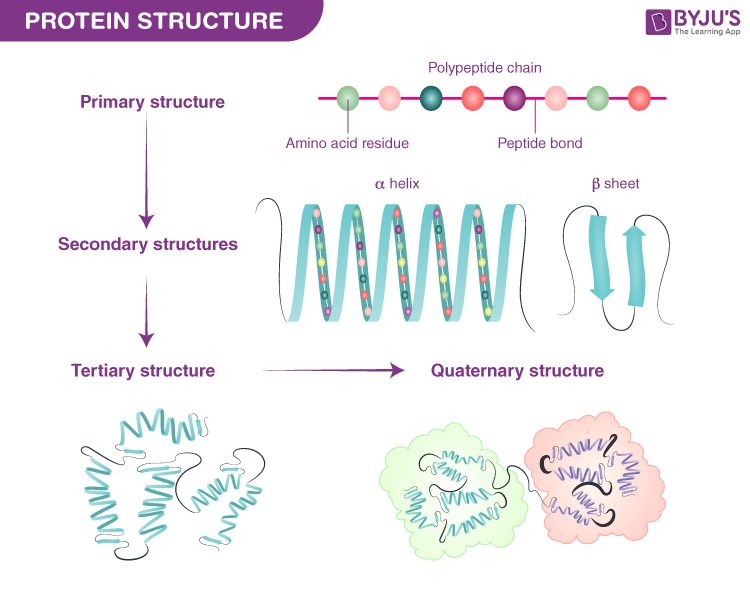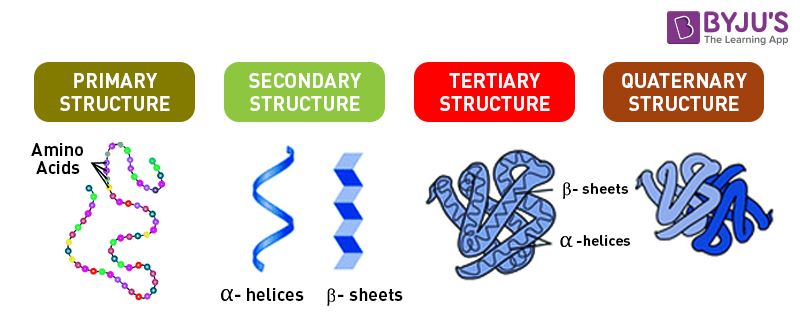Table of Contents
What are Proteins?
Proteins are known as the building blocks of life because they are the most abundant molecules present in the body and form about 60% of the dry weight of cells.

They make up the majority of the cells in all living things. Aside from cells, proteins make up the majority of the body’s structural, regulatory, and enzyme components. They are therefore crucial for an individual’s growth and development.
Food like eggs, pulses, milk and other milk products form the major high-protein foods for the body.
Also read: Proteins, Denaturation of Proteins
Proteins Structure
A polymeric chain of amino acid residues constitutes proteins. A protein’s structure is primarily made up of long chains of amino acids. The arrangement and placement of amino acids give proteins certain characteristics. All amino acid molecules contain an amino (-NH2) and a carboxyl (-COOH) functional group. Hence, the name “Amino-Acid”.

Polypeptide chains are synthesized by linking together amino acids. A protein is created when one or more of these chains fold in a specific way. Methane is substituted by amino acids, with hydrogen, amino groups, carboxyl groups, and a variable R- group filling the first three valencies of the – alpha carbon.
There are many sorts of amino acids depending on the R-group, and a polypeptide chain contains 20 of them. The final structure and purpose of proteins are determined by all these characteristics of amino acids.
The structure of the protein is classified at 4 levels:-

- Primary – The primary structure of a protein is the linear polypeptide chain formed by the amino acids in a particular sequence. Changing the position of even a single amino acid will result in a different chain and hence a different protein.
- Secondary – The secondary structure of a protein is formed by hydrogen bonding in the polypeptide chain. These bonds cause the chain to fold and coil in two different conformations known as the α-helix or β-pleated sheets. The α-helix is like a single spiral and is formed by hydrogen bonding between every fourth amino acid. The β-pleated sheet is formed by hydrogen bonding between two or more adjacent polypeptide chains.
- Tertiary – The tertiary structure is the final 3-dimensional shape acquired by the polypeptide chains under the attractive and repulsive forces of the different R-groups of each amino acid. This is a coiled structure that is very necessary for protein functions.
- Quaternary – This structure is exhibited only by those proteins which have multiple polypeptide chains combined to form a large complex. The individual chains are then called subunits.
Also, Read: Creutzfeldt-Jakob Disease
Functions of Proteins
The body uses proteins for a variety of purposes, and their structure determines how they work. Several notable functions include:
- Digestion – The digestive enzymes, which are primarily proteinaceous in origin, carry out digestion.
- Movement – Muscles include a protein called myosin, which helps muscles contract, allowing for movement.
- Structure and Support – The structural protein known as keratin is what gives humans and other animals hair, nails, and horns.
- Cellular communication – Through receptors on their surface, cells can communicate with other cells and the outside world. These receptors are made of proteins.
- Act as a messenger – These proteins serve as chemical messengers that facilitate communication among cells, tissues, and organs.
Also refer: Biomolecules
Learn more about Proteins, their types, sources, importance and other related topics at BYJU’S Biology

Really helpful to me thank u so muchhhh